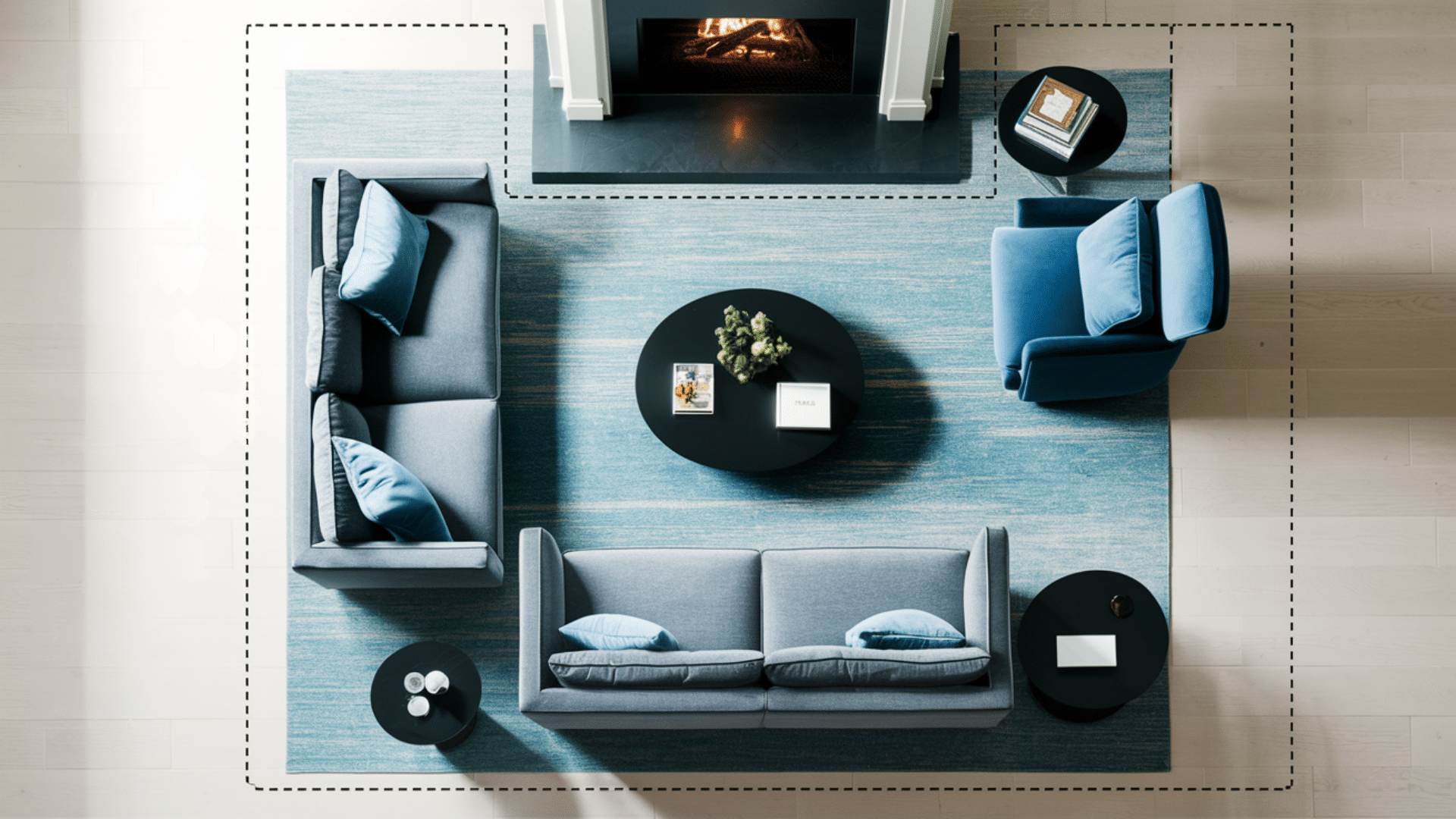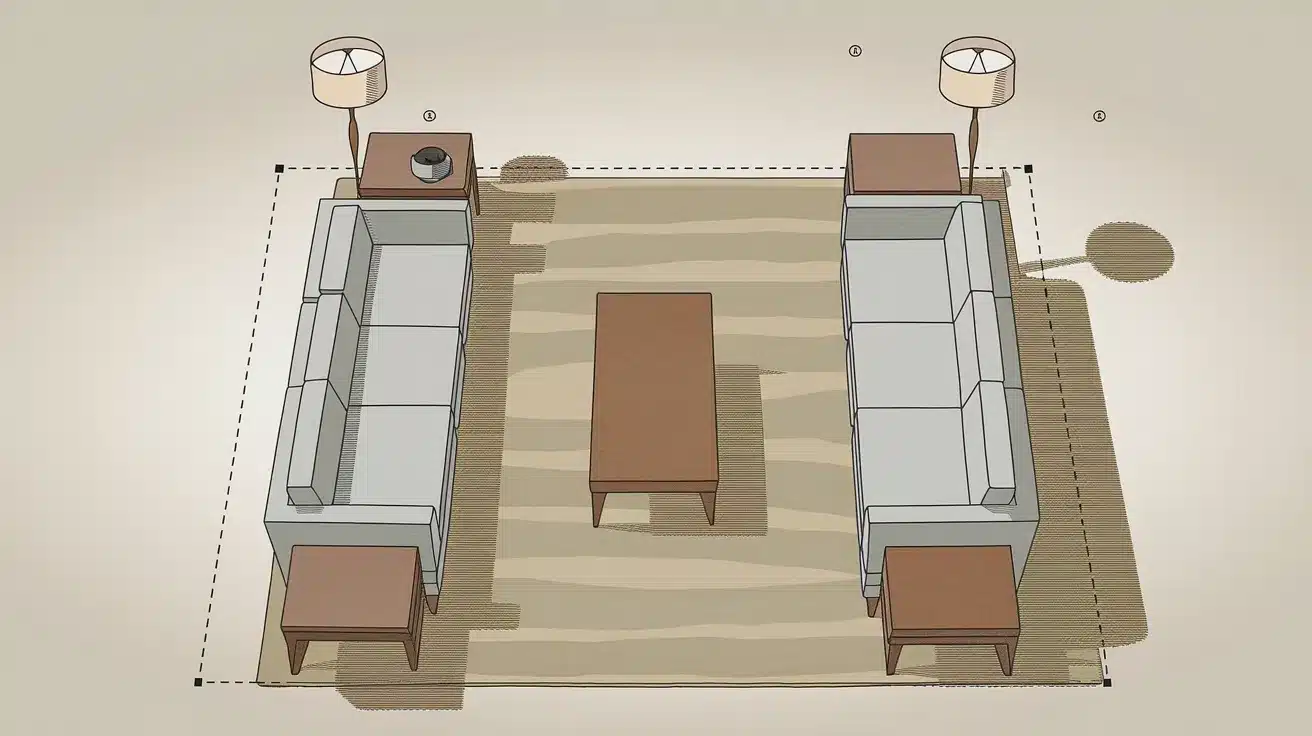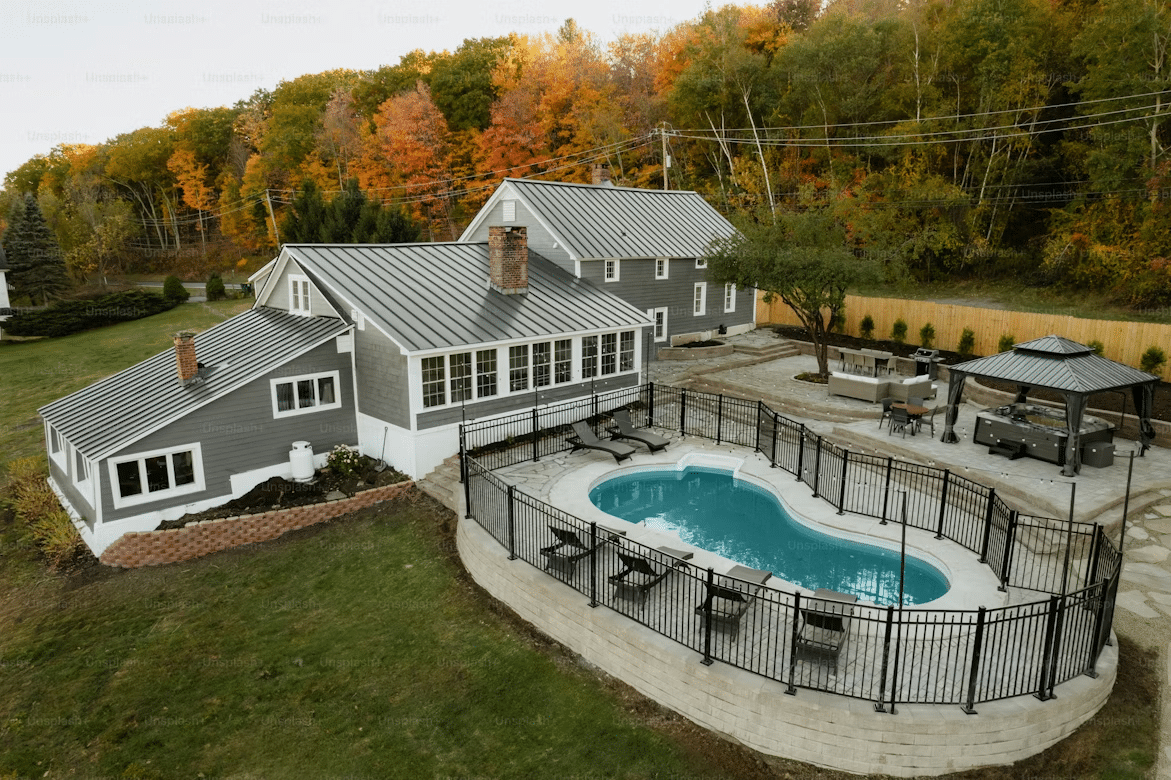Starting fresh in a new space?
Many homeowners feel stuck when placing furniture in their living rooms.
What seems simple on paper often becomes tricky in real life, with questions about where to put the sofa, how to handle the TV, and what to do with those awkward corners.
Good news: Creating a functional and welcoming living room doesn’t require special skills.
Having helped hundreds of clients with their spaces, I’ve learned that successful furniture arrangement follows simple, proven patterns that work in any room.
Ready to make your living room work better for you?
This guide is here to help you, providing step-by-step methods to arrange your furniture just like a pro!
Essential Planning Steps To Arrange Your Living Room
Before moving any furniture, taking time to plan your living room layout sets you up for success.
Here are the key steps to consider:
Choose Your Main Focus
Your living room needs a focal point for furniture.
A fireplace serves as a natural anchor, while a TV can substitute if absent.
Large windows with a view can also act as a focal point, guiding your seating arrangement.
Consider these questions when selecting your focal point:
- What do you use the room for most often? (TV watching, conversation, reading)
- Which element draws attention naturally when entering the room?
- How will your chosen focal point affect daily activities?
Consider Traffic Patterns
Understanding how people move through your space is crucial for a comfortable layout.
Start by marking the main paths people take:
- From entrance to exit points
- Between different seating areas
- Around large furniture pieces
Leave 30-36 inches for main walkways.
For spaces between the sofa and coffee table, 18 inches allows comfortable reach and flow.
Ensure doorways and high-traffic zones remain clear and accessible.
Pro Tip: Mark furniture positions with tape on the floor. Walk through the space to ensure the flow is natural and unobstructed.
Remember to account for:
- Daily routines and movement patterns
- Space needed when furniture is in use (like pulled-out chairs)
- Room for opening doors and windows
- Access to electrical outlets and light switches
Popular Layout Options For Living Room
Let’s explore tried-and-true furniture arrangements that work well in most living rooms.
1. Traditional Face-To-Face Setup
This classic arrangement creates an intimate setting perfect for conversation. Here’s how to achieve it:
- Place two sofas directly opposite each other
- Add a rectangular coffee table between them
- Include a pair of end tables for balance and function
- Allow 18 inches between the coffee table and seating for easy movement
Alternative Version: Replace one sofa with two comfortable chairs for more flexibility and visual interest.
This works especially well in smaller spaces while maintaining the same welcoming feel.
2. L-Shaped Arrangements
Perfect for rooms where you want to define separate areas or make the most of corner spaces:
- Position the longest part of the seating against the larger wall
- Face the TV or fireplace directly from the main seating area
- Add an accent chair to complete the seating group
- Use a rug to unify the arrangement
Best Suited For: Rooms with multiple functions or open floor plans where you need to create distinct zones.
3. U-Shaped Seating
Ideal for larger spaces and homes that frequently host gatherings:
- Center a sofa facing the main focal point
- Add chairs or loveseats on both sides, forming a U-shape
- Place a large coffee table or two smaller tables in the center
- Include side tables between seating pieces for convenience
Tips for success:
- Keep 3-4 feet between opposing seats for comfortable conversation
- Ensure all seats have easy access to tables for drinks and items
- Create clear pathways into and out of the seating area
Remember: Your chosen layout should reflect how you actually use the room.
For TV viewing, prioritize comfort. For hosting, create conversation-friendly groupings.
4. Sofa with Flanking Chairs
A space-efficient setup that works well in both small and medium rooms:
- Center your sofa on the main wall
- Place matching chairs on either side, angled slightly inward
- Add a coffee table in the center
- Include small side tables between the sofa and chairs
This layout creates a cozy, balanced look while maximizing seating.
The angled chairs make the space feel welcoming and keep the conversation flowing naturally.
Tip: Aim for 15-20 degrees toward the sofa when angling the chairs.
This subtle turn creates better sight lines for conversation while keeping the room looking organized.
5. Floating Furniture Layout
Perfect for rooms with limited wall space or multiple windows:
- Position furniture away from walls to create an island effect
- Center the seating arrangement on a large area rug
- Place the sofa several feet from the wall
- Add chairs to complete the grouping
- Use console tables behind floating pieces for visual balance
This arrangement helps define spaces in open floor plans and creates interesting walkways around the furniture.
Tip: Select a sofa table matching your sofa’s length for a floating layout.
This creates a cohesive look and a perfect space for lamps and decor.
6. Split-Level Solution
Ideal for homes with split-level living rooms or subtle room dividers:
- Create two distinct seating zones
- Use the first area for TV viewing or main activities
- Design the second space for reading or quiet conversation
- Connect both areas with complementary rugs
- Maintain consistent style elements across both zones
Remember: Use matching throw pillows in both zones to create a visual connection without identical spaces.
This repetition helps the eye move between the areas while maintaining distinct functions.
Furniture Placement Rules for Your Living Room
Following these fundamental rules will help you create a living room that’s both functional and comfortable.
Let’s break down the essential guidelines for furniture spacing and placement.
1. Distance Guidelines
The right spacing makes your room feel natural and easy to use. Here are the key measurements to remember:
For Seating Areas:
- Keep 18 inches between the coffee table and sofa/chairs for easy reach
- Leave 30-36 inches of walking space around furniture
- Allow 7-8 feet between seats facing each other for comfort
- Position side tables within arm’s reach of seating
For TV Viewing:
- Place seating 8-12 feet from a standard TV screen
- Set the TV at eye level when seated
- Angle chairs no more than 45 degrees from the screen
- Keep glare-causing light sources away from viewing areas
2. Window and Door Considerations
Smart placement near openings keeps your room bright and accessible:
Window Tips:
- Keep furniture a few inches from windows
- Avoid blocking natural light sources
- Use low-profile pieces under windows when needed
- Consider window-opening clearance
Door Guidelines:
- Leave 3 feet of clear space around doorways
- Create clear paths to all room entrances
- Ensure doors can fully open without hitting furniture
- Keep main traffic routes open and direct
Additional Tips:
- Face seats toward entry points when possible
- Position tall pieces against walls to maintain openness
- Balance heavy items throughout the room
- Keep tables at comfortable reaching height from seats
Remember: Measuring your space before buying or moving furniture saves time and prevents costly mistakes. A quick sketch with dimensions can help you visualize how everything will fit together.
Common Layout Mistakes To Avoid
1. The Wall-Hugging Habit: Pushing furniture against walls is believed to enlarge rooms but creates awkward spaces and disrupts conversations.
Instead, pull furniture away to form intimate seating areas.
A few inches behind pieces can enhance room spaciousness and design.
2. Ignoring Traffic Flow: Blocking pathways with furniture frustrates movement.
Squeezing past chairs or bumping into table corners makes the room uncomfortable.
Maintain clear paths (30-36 inches) between seating areas and doorways.
Observe family movement and arrange furniture accordingly.
3. Choosing the Wrong Rug Size: A small rug in your seating area makes the room feel disconnected.
Choose a rug large enough for at least the front legs of all seating to rest on it; a 9×12 foot rug is ideal for average living rooms.
This creates a unified seating space.
4. Mixed-Up Proportions: A small coffee table in front of a large sectional disrupts visual balance.
Each piece should be proportional to the room and surrounding furniture.
The coffee table should be two-thirds the length of the sofa, with wide walkways for comfortable movement.
Final Thoughts
Creating an effective living room layout might take some trial and error, but the results are worth the effort.
Remember that your room’s arrangement should reflect how you live, not just how it looks in photos or magazines.
Start with your focal point, plan your traffic flow, and choose a layout that fits your space and lifestyle.
Don’t be afraid to pull furniture away from walls or experiment with different arrangements until you find what works best.
Most importantly, give yourself time to live with a new layout before making final decisions.
Your perfect arrangement will balance both beauty and function, creating a welcoming space where family and friends naturally gather and conversation flows easily.
Ready to rearrange?
Grab some help and start moving furniture today!














